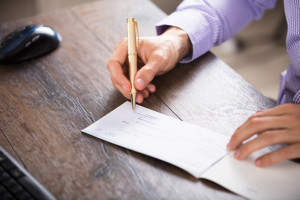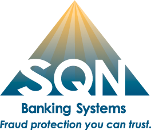 Counterfeit checks include any checks that have been created fraudulently with the purpose of stealing money from someone. This category can include fake cashier’s checks, money orders, personal checks, and business checks. In some cases, all the information on the check is fake, but in other situations, scam artists create counterfeit checks using real account and routing numbers. To learn more about counterfeit checks, look at these frequently asked questions and answers.
Counterfeit checks include any checks that have been created fraudulently with the purpose of stealing money from someone. This category can include fake cashier’s checks, money orders, personal checks, and business checks. In some cases, all the information on the check is fake, but in other situations, scam artists create counterfeit checks using real account and routing numbers. To learn more about counterfeit checks, look at these frequently asked questions and answers.
How Common Are Counterfeit Checks?
With more and more people turning to debit cards and other electronic payment methods, check fraud may seem like a small issue, but unfortunately, that is not the case. Every year, money hungry thieves issue millions of counterfeit checks worth billions of dollars. Annually, about half a million Americans become the victim of scams involving fake or counterfeit checks, and the Better Business Bureau (BBB) reports that victims lose an average of $1,200 each. In addition to the losses suffered by businesses and individuals, financial institutions can also lose money from counterfeit checks.
What Are the Signs of a Counterfeit Check?
Several different elements can indicate that a check is counterfeit. Some of the most common red flags include the following:
- Unusual check amounts — particularly, checks written for over the purchase price or over the amount needed by the depositor
- Often under $5,000 to avoid longer hold times
- Inaccurate account holder details such as fake business names or addresses
- Checks written for “cash” instead of to a payee name
- No bank logo or address on the check
- Faded bank logo, which can mean the check was copied from an original
- Fraudulent bank name or address, especially on cashier’s checks
- Absence of security features such as watermarks or security threads
- Misspellings
- Shiny MICR numbers, whereas real MICR ink tends to look dull
- No routing number or routing numbers without nine digits
- Smooth edges on personal checks, indicating they were printed from a home computer
- Missing signatures
- Stains or gaps around signatures, which often means the signature was copied onto the check
- Up and down pen strokes associated with forged signatures
Both your customers and your tellers should be aware of the signs that a check is counterfeit, and they should understand the most common scams involving counterfeit checks.
How Do Thieves Use Counterfeit Checks?
Thieves may create counterfeit checks and deposit the funds into their own accounts. They may steal checking account details from their employers, issue checks to a fake vendor, and keep the money for themselves. Often, when thieves counterfeit checks, however, they convince victims to take the fake check and give them some change in return.
To convince victims to take these steps, scam artists use a variety of different techniques. For instance, they may reach out to people who are selling something and offer to pay more than the sale price if the recipient agrees to accept a cashier’s check or a money order. Alternatively, they may tell the victim they have won a foreign lottery, and they just need to pay some fees or tax. Or, they may offer the victim a fake job reviewing wire transfer services or cashing checks.
In all cases, these scams feature three core elements:
- The victim accepts a counterfeit check, cashier’s check, or money order.
- The counterfeit check is for more than the amount needed.
- The victim gives the scam artist some change (usually through a wire transfer but sometimes in cash) for the counterfeit check.
Regardless of the exact scam involved, the potential outcome is the same — the scam artist absconds with the cash, and the victim gets stuck with a loss. If the victim can’t cover the loss, your financial institution may end up bearing the brunt of an overdrawn account.
How Can Customers Protect Themselves Against Counterfeit Checks?
Your first line of defense in fighting fraud is to educate your customers. Let customers know about the most common scams involving counterfeit checks and give them tips on how to avoid these scams. You may want to create unique educational materials for your individual and business clients as they face slightly different risks. For example, individuals may be more likely to be targeted by thieves running a foreign lottery scam, while business customers may be more susceptible to internal fraud related to counterfeit checks.
How Can You Protect Your Financial Institution from Counterfeit Checks?
Your tellers should be aware of the telltale signs of counterfeit checks. They should alert a manager or another appointed person when they suspect a customer is trying to deposit a counterfeit check, and when accepting large checks, they should ask customers if they know and trust the check writer.
Ideally, you should automate as much of this process as possible. The right products can scan on-us checks and look for issues with stock elements or check content, that is not perceptible to the human eye. When issues are detected, these tools display the suspicious check in a workflow application next to other details such as saved signatures that guide your staff as they manually decide if a check has a risk of being counterfeit or not.
Real-time fraud protection tools that look for aberrations in spending and deposit patterns can also be extremely useful, especially in the detection of counterfeit cashier’s checks written for large amounts.
Unfortunately, financial institutions must make the funds available from deposits relatively quickly. Typically, funds drawn on U.S. Treasury checks, most government checks, cashier’s checks, certified checks, and teller’s checks must be available the next business day, and without fraud detection tools in place, that means the funds can be quickly spent before you find out whether or not the check is counterfeit.
Your financial institution needs quality fraud detection products and services in place to protect your bottom line, your customers, and your reputation. We can help. To learn more, contact us at SQN Banking Systems today.
